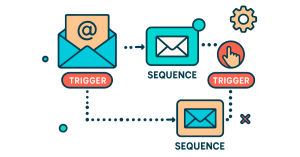When it comes to automation mistakes, we’ve seen it all. Beautifully mapped email sequences with a dozen steps but no clear call to action. One-size-fits-all nurture campaigns that ignore user behavior. Triggers that fire too soon or too late.
These common missteps can quietly stall even the most well-planned funnel, but the good news is that most of them are easy to fix. Let’s break down five of the most frequent automation mistakes and how to fix them.
1. Overcomplicated Workflows
When automated campaigns try to do too much at once, they often stop working as intended. Instead of guiding customers smoothly from one step to the next, these complex setups can confuse both the system and the audience.
Messages get delayed or sent out of order, and it becomes hard to tell what’s working. If potential customers stop opening emails or clicking through, the problem might not show up right away, but it can quietly drag down results over time.
The Fix
Start with one goal and reverse-engineer the steps. A three-email post-purchase series with a single call to action will almost always outperform a ten-email journey that tries to educate, upsell, re-engage, and survey all at once.
High-Impact Workflow Example
After a purchase, send a thank-you email that confirms the order and sets expectations. A few days later, follow up with tips to help the customer get the most out of the product. Then, close the loop with a single request for feedback or a review. Each message serves one purpose and keeps the path forward clear.
2. Poor Segmentation
Sending the same message to every contact leads to low open rates, fewer clicks, and more unsubscribes. Audiences expect relevance, and when emails miss the mark, engagement drops.
According to HubSpot, segmented campaigns generate 30% more opens and 50% more clicks than non-segmented ones, which is a clear sign that personalized, behavior-based messaging performs better across the board.
The Fix
Segment based on behavior. Build dynamic segments that shift based on recent activity or purchase stage with tags like “clicked Product A” or “visited pricing page.” Most modern platforms offer predictive AI tools to take this even further.
High-Impact Workflow Example
Instead of blasting a general discount to your entire list, send a targeted offer only to contacts who viewed a specific product category in the last 14 days, increasing relevance and conversion potential.
3. Misaligned Triggers
When automation triggers don’t match a contact’s behavior or intent, even the most well-designed workflow can fall flat. Poorly timed messages create confusion, disrupt the customer journey, and weaken trust.
For example, sending a re-engagement email just days after someone makes a purchase not only feels irrelevant, it signals that the brand isn’t paying attention.
The Fix
Align triggers with meaningful user actions that signal intent. Instead of relying on time-based delays or generic entry points, use behavioral events—like a product view, cart abandonment, or form submission—to kick off relevant sequences. This ensures the timing and message match where the contact is in the journey.
High-Impact Workflow Example
Set a webinar follow-up to trigger only after someone attends the session, not just when they register. Customize the content based on the session topic, such as sending a related guide or product demo link, rather than dropping them into a generic sales drip.
4. No Clear CTA
Emails without a single focus confuse readers.
If you ask them to schedule a call, download a guide, and follow you on social all in one message, they’ll likely do none of the above.
The Fix
Give every email one specific job. Whether it’s “Book a Demo,” “Read the Full Guide” or complete a purchase, make that action clear and easy to follow. When you remove distractions and make the next step obvious, you reduce decision fatigue and increase the likelihood that readers will take action.
High-Impact Workflow Example
An onboarding sequence might include three emails, each with a single button: “Complete Your Profile,” “Explore Features,” and “Book Your Training Call,” guiding users step-by-step without overwhelming them.
5. Untested Automations
Automations that are not reviewed often enough become invisible problems.
What worked a year ago may not reflect your current products, audience behavior, or messaging. Without regular updates, you risk sending irrelevant content or missing opportunities to optimize.
The Fix
Review core workflows at least once a quarter. A/B test subject lines, content, and timing. Watch for drop-off points. If people open but don’t click, revise the CTA. If they click but don’t convert, tweak the offer. Add fallback logic to catch disengaged leads and reroute them into a re-engagement or nurture flow, and set calendar reminders so nothing goes unchecked for too long.
High-Impact Workflow Example
If a lead hasn’t engaged with your emails in 60 days, trigger a re-engagement sequence with a special offer or survey to win them back before removing them from your active list.
FAQ: Smarter Automation Starts Here
Once you’ve addressed major automation pitfalls, the next step is refinement. Check out the FAQ below for questions we often hear from clients who want stronger, more streamlined automations.
How do I know if my automation is helping or hurting?
Look at the data. Low click-through or conversion rates, high unsubscribe rates, and long gaps between user activity are all red flags. A growing list with declining engagement is also a warning sign indicating your messages may not be resonating.
What are some low-effort, high-impact changes I can make?
Often, fixing just one or two emails in a long sequence can improve funnel health. Try these:
- Simplify CTAs in one workflow: Make it obvious what comes next.
- Test stronger subject lines: Higher opens lift all your metrics.
- Tighten timing: Reduce dead space between steps.
- Remove filler: If a message doesn’t serve a purpose, cut it.
How often should I audit or update my automated campaigns?
Set calendar reminders for quarterly check-ins. Review content, performance data, and triggers. Any time your offer, audience, or strategy changes, revisit your automations.
Think of audits as routine maintenance. The more you do them, the less likely it is that small problems turn into performance killers.
How many automated workflows is too many?
If you’re seeing overlaps, conflicting messages, or simultaneous sends, you may be running too many. Each workflow should have a clear purpose, a defined entry point, and an end.
Should I personalize every automated email?
Only if it adds value. Tailor messages based on behavior or lifecycle stage instead of using the first name token in every subject line. Aim for meaningful, not mechanical.
Need help identifying where your automation is underperforming?
At emfluence, we help brands turn underperforming automations into high-converting, easy-to-manage workflows. Whether the goal is simplifying a complex funnel or increasing engagement in an existing campaign, we deliver tailored strategies that drive results (with no full rebuild required.)
Our platform and support team make it easy to build, test, and refine campaigns that align with your goals and grow with your business.
Ready to make your automation smarter, faster, and more effective? Reach out anytime at expert@emfluence.com.


